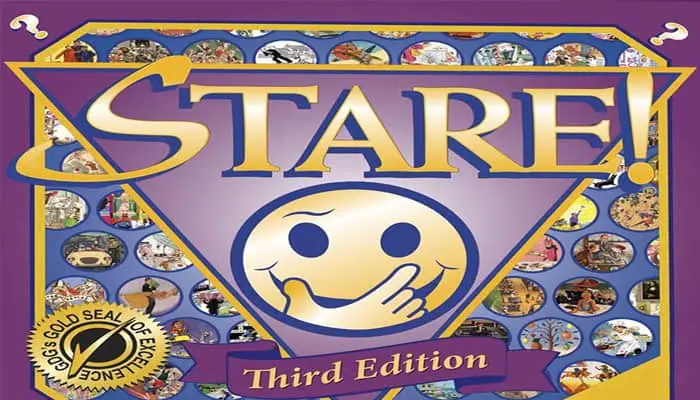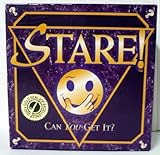

Components
- 240 image cards with 1440 questions,
- Game Board
- Sand timer
- Playing pawns
- Die
- Instructions
Object of the Game
Stare! challenges how much players can recall about images they see on the game cards. Players move around the board by correctly answering questions about the images.
The first player/team to reach the FINISH triangle is the winner of the game. (Note: if you don't have much time, play until someone reaches the 'Short Game' triangle in the middle of the board).
Getting Started
If there are four or more players, divide into teams (it's fun to consult with teammates about guesses). Each player/team chooses a game piece and places it on the START triangle.
The die is then rolled to see who goes first (highest roll wins). Players/teams take turns moving clockwise.
Game Play
If it's your turn first, draw a card and then stare at the image for 20 seconds (an opposing player/team will flip the 10-second timer over twice). Try to memorize as much detail as you can.


Once time runs out, pass the card to the person/team to your left, who will ask you questions about the image (they should be careful not to let you see the image).
You then roll the die to see which question you will be asked first (e.g. roll a '5' and you will be asked Question '5'). Once you give your answer, the person/team holding the card looks at the image to see if you are right - they are the judge!
The 'judge 'should look at the image very carefully to see if the answer given is correct, because sometimes the right answer isn't obvious at first glance.

If you answer correctly move ahead by the number on the die (if you roll a '5', and answer Question 5 correctly, move ahead 5 spaces). Now roll again to get your next question from the same card (roll a '3' and you'll be asked Question 3 - answer correctly and you move ahead 3 spaces).
Every time you get a question right move ahead, and then roll again for your next question. (Note: Questions are organized so that ' 1 ' is usually the easiest question, and '6' the hardest).
End of the Round
Your turn continues until you either get a question wrong or until you roll the same number twice, which is called rolling out (meaning that you cannot answer the same question twice).
In either case, your turn is over and play passes to the next person (who draws a new card from the card box).

Notes
-
Opponents Choice Question
Each card has one question marked "Opponents' Choice". This option allows an opponent to make up the question for you to answer. You choose which player/team will make up the question to ask.
Opponents have only 20 seconds to come up with a question (flip the timer over twice), or you get to move ahead automatically. An opponent may not ask a question which is too obscure (the answer must be clearly determinable).
If you get an "Opponent's Choice" question right, move ahead by the number on the die and then roll again to continue your turn. But if you get the question wrong, the opponent asking the question gets to move ahead by the number on the die (and your turn is over).
Opponents, be careful what questions you make up: what goes around comes around!
-
Double or Trouble Spaces
If you land on one of the spaces marked 'Double or Trouble', roll the die as you normally would to see which question you will be asked.
Here's the twist: if you answer correctly you move ahead by double the amount on the die (move 10 spaces if you answer Question 5, 6 spaces if you answer Question 3, etc). But if you answer incorrectly, or if you 'roll out', move backwards by the number on the die (thus ending your turn)!
-
Changing Skill Levels:
The timer is the key to changing the skill level of the game. The 20-second time limit described above is for the Challenging version. To make the game more difficult, try the Expert version: you have only 10 seconds to stare at an image (the timer is flipped over just once).
To make the game easier, especially when children are playing, try the General version: players have 30 seconds to stare at an image (the timer is flipped over three times).
When adults are playing against children, adults are given 20 seconds, children 30 seconds.
-
The Second Chance Rule (optional)
If players agree at the start, this rule is applicable during the entire game. Here's how it works.
When you get one question on a card wrong or you 'roll out' one time, instead of your turn ending you get a 'second chance': roll the die to receive your next question and continue your turn - but when you get any subsequent question wrong, or you 'roll out' again, your turn is over.
This rule allows you to get one question wrong during your turn, or to 'roll out' one time, and yet keep playing. It is a good way to prevent anyone's turn ending abruptly - and everyone likes a second chance! This rule is optional.

End of the Game
The winner is the first player/team who reach the finish triangle.
Alternative Gameplay - Fastplay
Here's an alternative gameplay that allows you to take advantage of all the questions on a card, and to gain spaces along the board more quickly. You DO NOT use the die, so put it aside. Instead, each player/team will be asked all six questions on the card.
Question 1 will be asked first, and if the player/team answers correctly they will move their game piece ahead 1 space on the board. If the player/team answers incorrectly, they will not lose their turn, but instead proceed to the next question without moving their game piece ahead.
Question 2 will then be asked (move ahead 2 spaces if you get it right, stay put if you are wrong), then Question 3, and so on until all 6 questions on the card are asked.
This means that if a player/team answers all six questions right, they would be able to move ahead a total of 21 spaces on the board (1+2+3+4+5+6).
You can't mix gameplays, so decide at the start if you want to play with the die or not. All players/teams must follow the same gameplay!
Continue Reading


